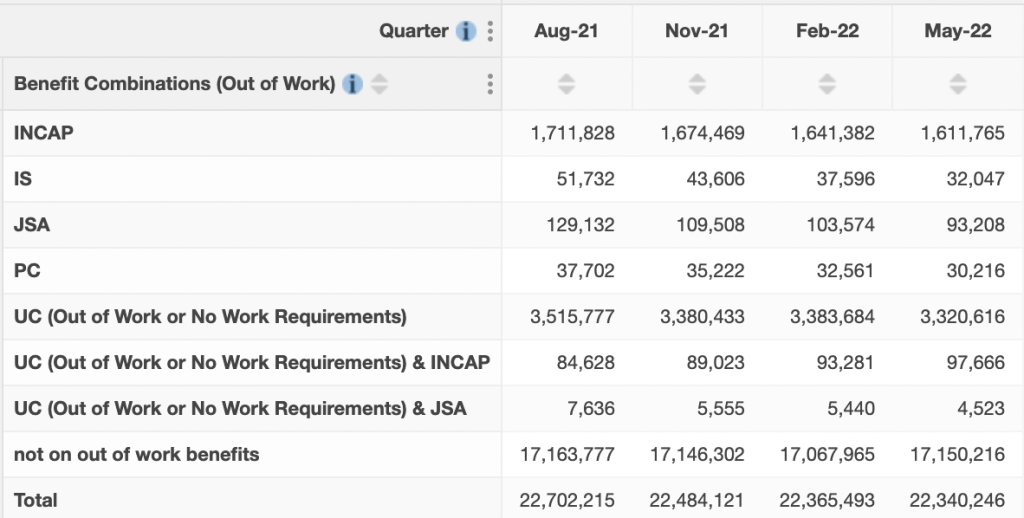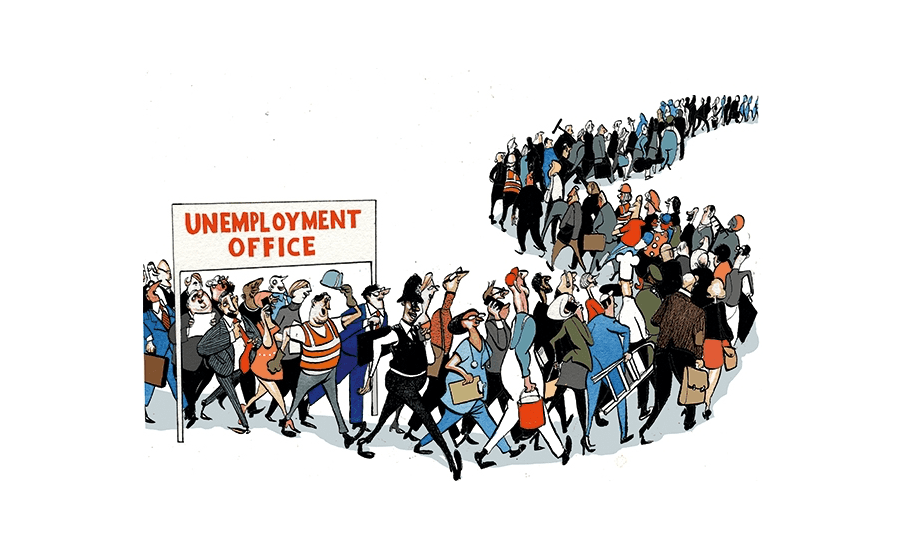How can 20 per cent of people in our great cities be on benefits at a time of mass migration and record vacancies? It’s perhaps the most important question in politics right now, but it’s not being given any scrutiny because the real figures lie behind a fog of data. But the fog is easily cleared, if you know where to look. What follows is for anyone with an interest in doing so, and it follows a few queries to The Spectator about how we found the five-million figure we’ve been using for a while.
To solve a problem, you need to recognise a problem
Every month, an official unemployment figure is put out on a press release – and news organisations are primed to cover it. It’s normally about 1.2 million looking for work: the problem, of course, is so few Brits are actually doing so. But the Conservatives have glossed over this point and had (pre-Sunak) taken to boasting that unemployment is at a 40-year low. In his last speech outside No10, Boris Johnson laid it on thick and said dole queues were shorter than any time since he was ‘on a space hopper’; Liz Truss made a similar boast as PM. But Rishi Sunak has not. There’s a decent chance that he will end the shameful cover-up and talk plainly about this huge issue.
The true benefits figure is not to be found on a press release, but buried in a password-protected DWP database with a six-month time lag. I don’t think the Tories intended to bury the bad news, but that is the effect of the rejig of their database. At The Spectator we have been tracking this measure since we were lambasting Labour for keeping five million on benefits during the boom. Here’s what it looks like…
The five million figure sounds so high as to be, quite literally, unbelievable. It was scrutinised on BBC Radio 4’s More or Less (episode here) but they didn’t go into detail. I mentioned it in a podcast recently and we were contacted by Full Fact, an independent watchdog who do a great job calling out people like me when we get figures wrong. I can see why they’d think it wasn't credible. If there were really five million on the dole – in the middle of an acute worker shortage – then surely the newspapers would be quoting this figure all the time? Didn’t the UK press go bananas when unemployment passed three million under Thatcher? So how could it be five million, without similar hype?
The five million figure ‘seems to be incorrect,’ Full Fact said in their email to us. ‘According to the most recent statistics, there are around 1.5 million people claiming out-of-work benefits.’ But the real figure is more than three times higher – but rather than reply to them, I thought I’d write this blog for anyone interested.
DWP data is now on Stat-Xplore, a versatile open data tool. The password bit is deceptive: you can bypass by clicking ‘Guest log in’ to find an Alladin’s Cave of data. Look at the dataset ‘Benefit Combinations – Data from February 2019'. Click Table 5, then click ‘Open table’ to get the numbers. A wheel appears while it computes, then the following table is revealed:

Add the figures on the right-hand column and you get 5.2 million. A call to the DWP press office will confirm that there is no overlap (every person is put in the category of the highest benefit they claim) and that 'out of work' is indeed the best phrase to describe them. The DWP offer no on-the-record guidance, for reasons that I’m unclear about. ‘Incap’ is Incapacity Benefit (or Employment Support Allowance – ESA – as it’s now known). IS is Income Support, which is being phased out. JSA is Jobseeker’s Allowance, now mostly replaced by the out-of-work part of Universal Credit.
There is a lot more you can do with this quite-versatile website. The data lag is six months (!) and it’s updated quarterly: the above is the November update, which runs to May. But it does allow you to look at the situation locally. Here’s a map, which my colleague John O’Neill has created. Quite a picture.
To fail to match up 1.2 million vacancies with at least some of those on out-of-work benefits is not just an economic failure but a moral one. But to solve a problem, you need to recognise a problem. Officially counting all five million people on out-of-work benefits would be a good way to start.
And a note to my critics
Ideally, an important study like this would be done by by a government department, or a think tank like the IFS. (The OBR has done great work, see here, but only occasionally). If officials are in no rush to publish embarrassing data, journalism can play a role in doing so. At The Spectator, we believe that journalism also means doing your own sums and hunting down your own metrics - it's hard to break new ground if you're using other people's metrics.
But might we be exaggerating for effect? The principle of The Spectator data hub is never to do so, and I'd like to reply to some people who have been so kind as to critique the above methodology
- We are using DWP language and methods: not our own. The DWP's definition of "out-of-work benefit", adding up categories and simply repeat the official wording. The OBR uses this method here (Chart E).
- The sharp rise in UC (Workless) We're repeating the official figures from the DWP. Its data may be corrupt, or its categories misleading. But we make no judgement about that, and repeat the official data with the official words.
- No double-counting The DWP say the figures do no double count. People are placed in the bracket of their highest welfare claim
- Yes, the figures include the terminally ill and those who cannot be expected to work. This critique is the main reason that this figure is not examined. In any society there will be some people who for various reasons are unable to work - but probably not 12 per cent of the potential workforce.
- If this five-million figure was real, why is no one else talking about it? Economists tend to focus on those actively looking for work, Tories have no incentive to highlight recent welfare failures and Labour dislikes the topic in general. Journalism has a bias towards readily-available and frequently-updated statistics- and these are buried deep in a DWP database.
I'd be grateful for any other challenge of thoughts. This is an under-explored part of public life, which arouses little general interest. Were it not for a couple of twists of fate, I'd have spent my life as one of these statistics. If this aroused half a much indignation as who gets into Oxford, we simply would not have such so much welfare dysfunction. I'd like to use what platform and influence I have to keep digging, and keep the conversation going. There is, still, all too much to say.







Comments